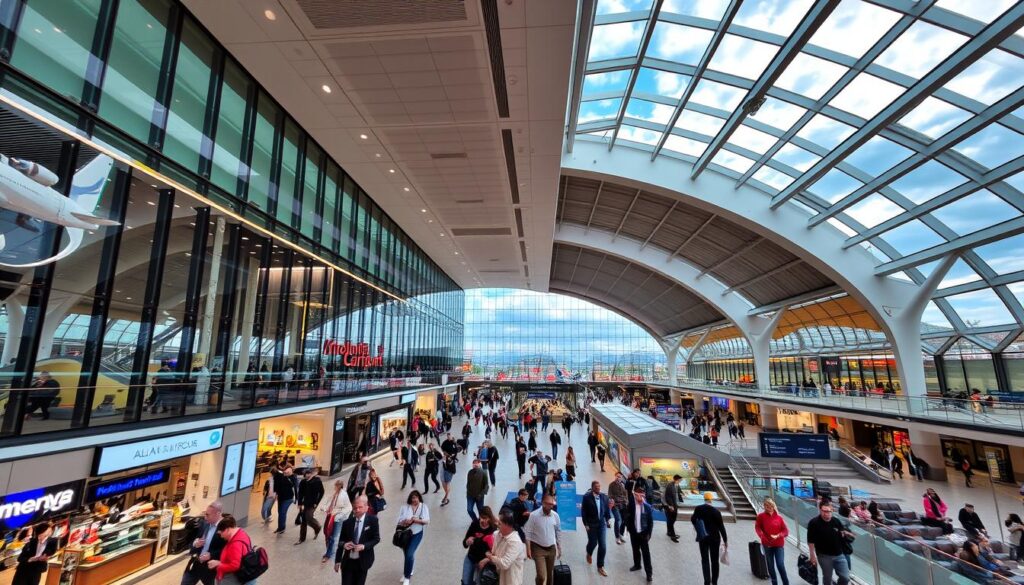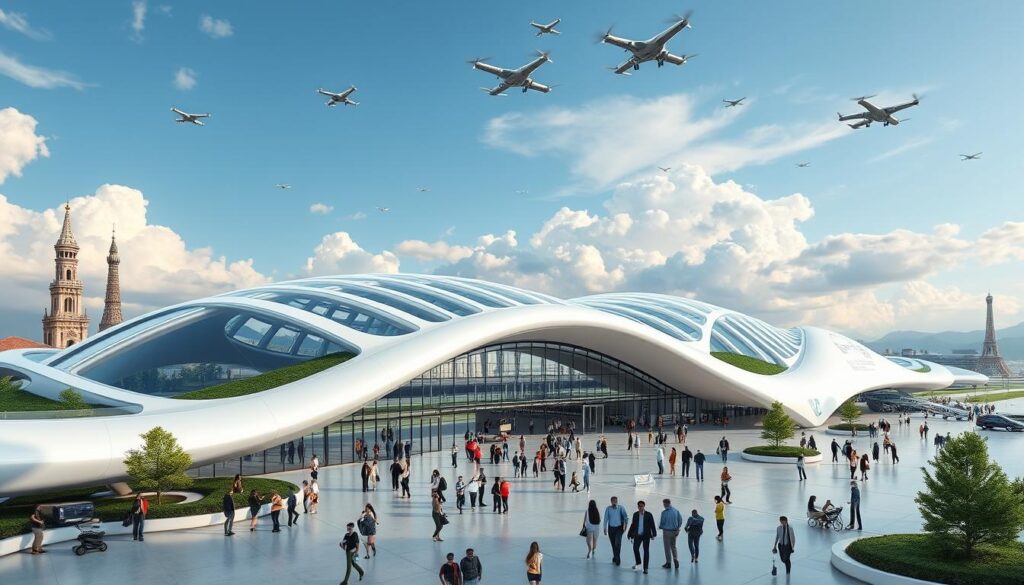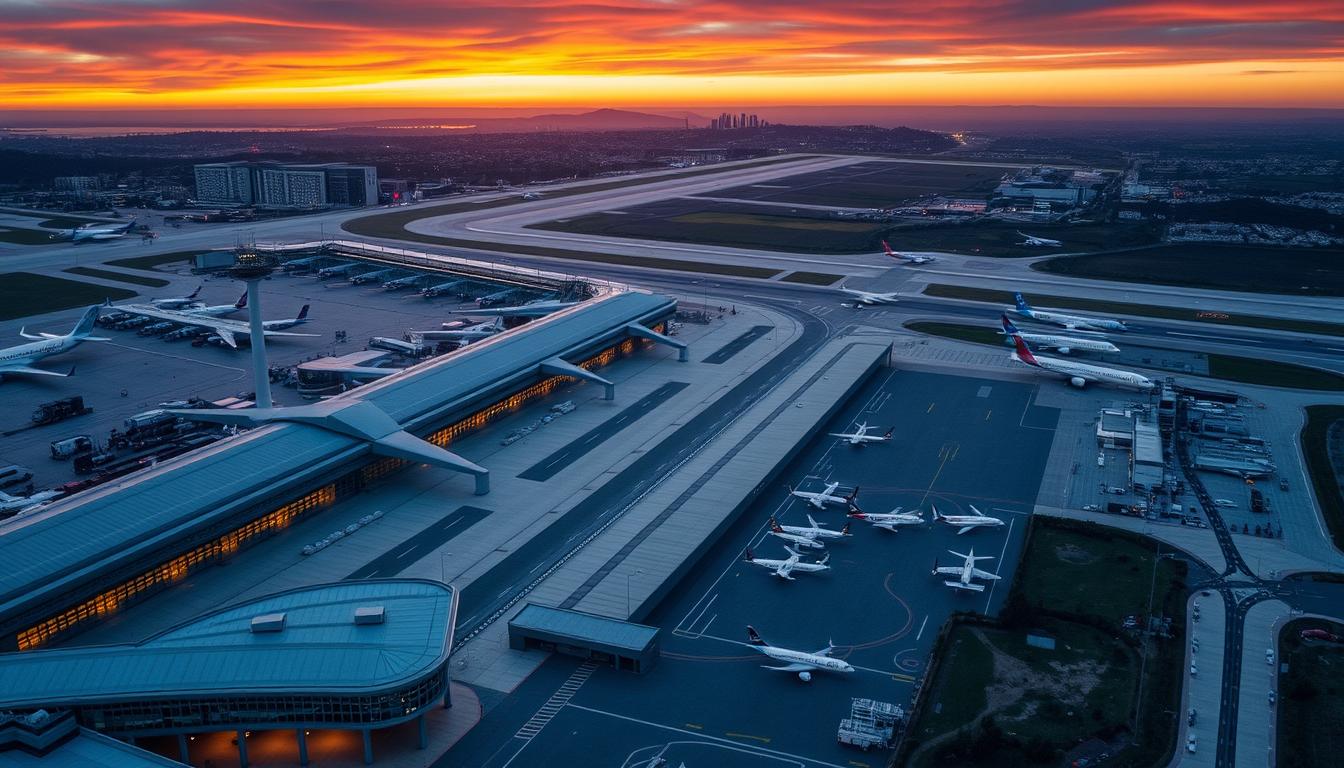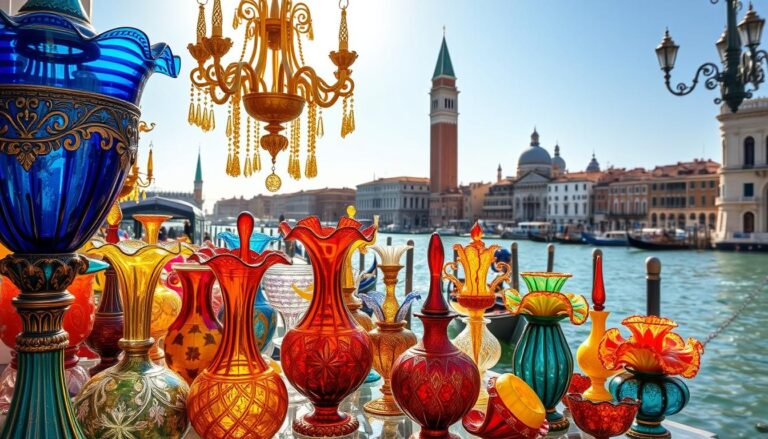Exploring the Top International Airports in Italy
Traveling to Italy starts when you arrive at one of its amazing international airports. You can’t wait to see ancient cities, try delicious food, and dive into the culture. These airports are the first stop on your Italian journey.
Italy’s airports are more than places to pass through. They are the beginning of your adventure in the Mediterranean. From Rome’s Leonardo da Vinci International Airport to Milan Malpensa, these places connect you to Italy’s beauty and life.
Every traveler finds something special in Italy’s airports. Whether you’re looking for a deal or luxury, there’s an airport for you. Each one offers a peek into Italy’s spirit and is your doorway to amazing experiences.
Table of Contents
Introduction to International Airports in Italy
Italy has a vast network of airports, key to connecting the country to the world. With over 130 airports, Italy’s aviation system supports tourism, business, and travel. This network is crucial for the country’s growth.
The main airports in Italy are well-placed for easy access. Rome Fiumicino Airport and Milan Malpensa Airport are the busiest, welcoming millions each year. They are the heart of Italy’s air travel.
“Italy’s airports are more than just transportation points; they are gateways to a world of cultural and economic opportunities.”
- Rome Fiumicino Airport is the busiest in Italy
- Milan Malpensa Airport serves millions of passengers each year
- Key regional airports include Bologna, Bari, and Palermo
These airports link Italy to Europe, North America, Asia, and the Middle East. They offer flights from budget-friendly to premium through airlines like ITA Airways, Ryanair, and easyJet.
| Airport | Location | Annual Passengers |
|---|---|---|
| Rome Fiumicino | Rome | Millions |
| Milan Malpensa | Milan | Millions |
| Venice Marco Polo | Venice | Significant Traffic |
Traveling to Italy for work or fun? Its airports offer great facilities and connections. They make your trip smooth and fun.
Major International Airports in Italy
Italy has a wide network of international airports. These airports serve millions of travelers every year. Knowing the airport codes and flight options makes traveling in Italy easier.
Three main airports in Italy connect travelers to places all over the world:
- Milan Malpensa Airport (MXP)
- Rome Fiumicino Airport (FCO)
- Venice Marco Polo Airport (VCE)
Milan Malpensa Airport Overview
Milan Malpensa Airport is about 30 miles from Milan’s city center. It’s a key hub for flights to Italy and beyond. It’s the second busiest airport in the country.
Rome Fiumicino Airport Overview
Rome Fiumicino Airport, with the code FCO, is Italy’s biggest international airport. It’s 20 miles from Rome’s center. In 2023, it welcomed 40.5 million passengers, a big jump from before.
Venice Marco Polo Airport Overview
Venice Marco Polo Airport (VCE) is a key entry point for northeastern Italy. It’s known for its long-haul flights. Travelers get to see the beautiful Venetian lagoon as they land.
| Airport | Code | 2023 Passengers | Key Features |
|---|---|---|---|
| Milan Malpensa | MXP | Not specified | Second busiest, cargo hub |
| Rome Fiumicino | FCO | 40.5 million | Largest international gateway |
| Venice Marco Polo | VCE | 11.3 million | Scenic international connections |
“Italy’s airports are not just transit points, but gateways to cultural experiences and global connections.”
Milan Malpensa Airport: A Closer Look
Milan Malpensa Airport is a top choice in Italy. It’s located northwest of Milan’s city center. It welcomes over 26 million passengers each year, offering flights to 382 routes in 77 countries.

The airport offers a smooth and comfortable travel experience. It has modern facilities and good transport links. It has two main terminals, each for different flights:
- Terminal 1: Long-haul international flights
- Terminal 2: EasyJet’s main base
Facilities and Services
The airport has many amenities to make your trip better. You can enjoy:
- Many dining options
- Duty-free shopping
- Comfortable lounges
- Free WiFi in all terminals
Airlines Operating at Malpensa
Malpensa is home to a wide range of airlines. It supports 134 airlines, including big names and budget airlines like:
- EasyJet (58 routes)
- Neos (36 routes)
- Many international airlines
Transportation Options
Getting to and from Malpensa is easy. You have several transport options:
- Malpensa Express Train:
- 147 daily services
- 50-minute to Milan Central Station
- Tickets are €13 one-way
- Terravision Buses:
- Every 30 minutes to central Milan
- 50-minute travel time
- Tickets are €10 each way
“Milan Malpensa Airport connects travelers seamlessly to the world, offering unparalleled convenience and comfort.” – Travel Expert
Malpensa offers many parking options, shuttle services, and connections. It makes your journey smooth, whether you’re traveling for business or leisure. This airport provides an outstanding travel experience.
Rome Fiumicino Airport Highlights
Rome’s Leonardo da Vinci International Airport is a top gateway to Italy. It offers a great airport experience with world-class services and design. Fiumicino is known as the Best Airport in Europe for airports with over 40 million passengers.
Terminal Information
Fiumicino Airport has a great infrastructure with many terminals. It serves about 100 airlines and connects to 230 routes across 70 countries.
- Total terminals: 4 operational terminals
- Routes: 230 international destinations
- Airlines: 100+ carriers
Dining and Shopping Experience
Your trip through Fiumicino is a fun adventure. The airport has a big commercial area. It recently opened a 6,000 square meter shopping zone with 21 shops.
| Shopping Area | Details |
|---|---|
| Total Commercial Space | 30,000 square meters |
| New Shopping Zone | 6,000 square meters |
| Number of Shops | 21 unique stores |
Accessibility Features
Fiumicino makes sure travelers are comfortable with its accessibility services. It’s recognized as a ‘Careport’, showing its commitment to inclusive travel for all.
“Fiumicino Airport: Where innovation meets hospitality” – European Aviation Review
Fiumicino Airport is just 32 kilometers from Rome. It has modern facilities, making your Italian trip start well. Its italy airport map connectivity is key for international travelers.
Venice Marco Polo Airport Insights
Venice Marco Polo Airport is a special gateway to Italy’s famous Venice. It’s just 13 kilometers from Venice’s center. This airport offers a unique travel experience, mixing modern ease with old-world charm.
Unique Airport Features
Venice Marco Polo Airport is known for its special transport options. You can travel to the city in several ways:
- Alilaguna Boat: A scenic 45-90 minute water journey
- ACTV Bus: Quick 20-25 minute land transfer
- ATVO Express Shuttle: Convenient 20-minute ride
- Water Taxi: Luxurious 30-45 minute canal experience
Popular Destinations from Venice
The airport is a key spot for travelers heading to many places. It’s easy to get to various exciting spots from Venice Marco Polo Airport.
| Destination Type | Number of Routes | Travel Options |
|---|---|---|
| Domestic Destinations | 30+ Italian cities | Direct flights |
| European Destinations | 50+ cities | Multiple airlines |
| Intercontinental Routes | 15+ countries | Long-haul flights |
Pro tip: Think about the different ways to get from the airport to Venice. Each option gives a different view of this amazing city.
“Venice Marco Polo Airport isn’t just a transit point – it’s the beginning of your Italian adventure.” – Travel Experts
Regional Airports Connecting Italy to the World
Italy’s regional airports are key in linking smaller cities to global destinations. They act as important entry points for those exploring Italy’s various regions. This makes the country more reachable for international flights.
Exploring Italy’s airports, regional ones offer special benefits for those looking for unique travel experiences. They provide essential links, making Italy more accessible to international visitors.
Florence Airport: Gateway to Tuscany
Galileo Galilei International Airport is just 3 km from Florence’s heart. It’s a major hub for Italy’s international flights. The airport offers:
- Direct connections to major European cities
- Easy access to the stunning Tuscany region
- Quick transport options for travelers
Naples International Airport: Southern Italy’s Aerial Connector
Naples International Airport is the main airport for southern Italy’s lively area. Its strategic spot makes it a hub for many international flights.
| Airport Details | Statistics |
|---|---|
| Total Passengers (2023) | 12,394,911 |
| Passenger Growth (2022-2023) | 13.5% |
| Total Aircraft Movements | 89,023 |
“Regional airports are the unsung heroes of international travel, connecting travelers to Italy’s hidden gems.” – Aviation Expert
These regional airports show Italy’s dedication to offering wide international flight connections. They ensure travelers can discover more than just big cities.
Comparing Large and Regional Airports
Choosing the right airport in Italy can greatly affect your travel experience. Knowing the differences between main airports helps travelers make better choices.
Italy has many airport options, from big international hubs to smaller regional airports. Each airport has its own benefits for travelers.
Advantages of International Airports
The top airports in Italy, like Rome Fiumicino and Milan Malpensa, offer great benefits for international travelers:
- Extensive global connections
- More frequent flight schedules
- Comprehensive passenger services
- Advanced transportation links
Milan Malpensa Airport, for example, handles about 26 million passengers a year. It’s a key entry point for international travelers, with direct flights to major cities.
Benefits of Regional Airports
Regional airports in Italy also have their own advantages:
- Shorter security lines
- Closer proximity to specific destinations
- Often more affordable parking
- Quicker check-in processes
“Travelers can save time and reduce stress by selecting the right airport for their specific journey.” – Italian Aviation Expert
When picking between main airports in Italy, think about your destination, travel time, and transportation options. Each airport has unique benefits that can make your Italian trip better.
Tips for Traveling Through Italian Airports
Traveling through Italian airports can be easy if you’re ready. Whether you’re landing at Rome Fiumicino, Milan Malpensa, or another big airport, knowing the local travel scene is key. It helps you make the most of your trip.
Airport Navigation Strategies
Here are some top tips for navigating Italian airports:
- Arrive at least 3 hours before international flights
- Check terminal information beforehand
- Download airport mobile apps for real-time updates
- Keep your passport and travel documents easily accessible
Security Procedure Insights
Italian airport security follows European standards. To be ready, remember:
- Remove liquids (under 100ml) for separate screening
- Have your electronic devices ready for inspection
- Wear easily removable shoes
- Keep travel documents in an accessible location
“Preparation is the key to stress-free airport experiences in Italy.” – Travel Expert
Local Transportation Options
Most Italian airports have many ways to get around:
- Train Services: High-speed trains like Leonardo Express connect airports to city centers
- Bus shuttles with frequent schedules
- Taxi and rideshare options
- Car rental facilities within airport premises
Knowing these tips will help you confidently move through Italy’s busy airports. You’ll have a smooth and enjoyable journey from start to finish.
Conclusion: The Future of Aviation in Italy

The world of Italy’s airports is changing fast to keep up with global travel needs. Italian airports are leading in new tech and green solutions.
Sustainability is key for Italy’s airports. Airlines are working hard to cut down on carbon emissions. They plan to make big changes to help the environment.
- Implementing low-carbon hydrogen technologies
- Exploring sustainable aviation fuel alternatives
- Developing energy-efficient airport infrastructure
The aviation world is set for big changes soon. Boeing predicts a need for 674,000 new pilots and 716,000 maintenance techs in 20 years. This shows Italy’s airports have a lot of room to grow.
“The future of aviation lies in sustainable innovation and passenger experience,” says a leading aviation expert.
New tech will change how you travel through Italian airports. Trends include:
- Advanced biometric security systems
- AI-powered passenger navigation
- Reduced carbon emission technologies
Italian airports aim to grow while protecting the environment. They plan to use the latest tech to cut down on CO2 emissions.
Frequently Asked Questions about Italian Airports
Traveling to Italy’s airports can be tricky for international visitors. Knowing about Italian airport codes and locations is key for a smooth trip. Each airport has its own features, like Rome’s Leonardo da Vinci–Fiumicino Airport and Milan Malpensa Airport.
Common Travel Inquiries
Italian airports have their own rules and steps. Italy is six hours ahead of the U.S. eastern time zone. Non-European visitors might face longer lines at immigration due to strict checks.
Also, Italy uses 220 Volts, so don’t forget your adapters for your gadgets.
Travel Regulations and Tips
Starting in 2024, new CT scanners at airports like Milan Malpensa and Rome Fiumicino let you carry more liquids. Be ready for more security checks and possible changes in baggage rules. Most Italian airports are well-connected, with Milan Malpensa and Rome’s airports being top choices for U.S. travelers.
Always check the latest travel rules before you go. Knowing the local airport codes and locations helps make your trip through Italy’s airports easier.







